

Back to Parents United for DC Public Schools main page
|
Columns DCWatch
Archives Elections Government and People Budget issues Organizations |
UNLEVEL PLAYING FIELDS
|
||||||||||||||||||||||||||||||||||||||||||||||||||||||||||||||||||||||||||||||||||||||||||||||||||||||||||||||||||||||||||||||||||||||||||||||||||||||||||||||||||||||||||||||||||||||||||||||||||||||||||||||||||||||||||||||||||||||||||||||||||||||||||||||||||||||||||||||||||||||||||||||||||||||||||||||||||||||||||||||||||||||||||||||||||||||||||||||||||||||||||||||||||||||||||||||||||||||||||||||||||||||||||||||||||||||||||||||||||||||||||||||||||||||||||||||||||||||||||||||||||||||||||||||||||||||||||||||||||||||||||||||||||||||||||||||||||||||||||||||||||||||||||||||||||||||||||||||||||||||||||||||||||||||||||||||||||||||||||||||||||||||||||||||||||||||||||||||||||||||||||||||||||||||||||||||||||||||||||||||||||||||||||||||||||||||||||||||||||||||||||||||||||||||||||||||||||||||||||||||||||||||||||||||||||||||||||||||||||||||||||||||||||||||||||||||||||||||||||||||||||||||||||||||||||||||||||||||||||||||||||||||||||||||||||||||||||||||||||||||||||||||||||||||||||||||||||||||||||||||
|
2000-2001 |
Ave. D.C. |
||||
|
Category |
D.C. |
Montgomery |
Fairfax |
Arlington |
Pay Difference |
|
Athletic Director |
$ 2,433 |
$ 3,850 |
$ 3,604 |
$ - |
$ 1,294 |
|
Football |
$ 2,280 |
$ 4,845 |
$ 3,604 |
$ 5,293 |
$ 2,301 |
|
Basketball |
$ 1,898 |
$ 4,233 |
$ 3,604 |
$ 4,048 |
$ 2,064 |
|
Baseball |
$ 1,898 |
$ 4,450 |
$ 3,396 |
$ 4,048 |
$ 2,067 |
|
Softball |
$ 1,898 |
$ 4,450 |
$ 3,396 |
$ 4,048 |
$ 2,067 |
|
Outdoor Track |
$ 1,898 |
$ 3,519 |
$ 3,396 |
$ 4,048 |
$ 1,756 |
|
Volleyball |
$ 1,898 |
$ 3,124 |
$ 3,396 |
$ 3,269 |
$ 1,365 |
|
Soccer |
$ 1,590 |
$ 3,213 |
$ 3,396 |
$ 3,737 |
$ 1,859 |
|
Swimming |
$ 1,590 |
$ 2,741 |
$ 3,396 |
$ 2,491 |
$ 1,286 |
|
Tennis |
$ 1,590 |
$ 2,882 |
$ 1,752 |
$ 2,491 |
$ 785 |
|
Cheerleaders |
$ 1,140 |
$ 6,719 |
$ 3,396 |
$ 3,269 |
$ 3,321 |
Almost all D.C. coaches are also classroom or physical education teachers and are already paid less than most of their suburban counterparts. The many hours required for coaching, including its heavy responsibilities for student supervision, make it an experience that most D.C. teachers cannot afford. Moreover, the limited funding discourages the formation of new teams and invites violations of Title IX, particularly for less well-established sports. For example, since funds are so limited, the stipend schedule classifies soccer as a coeducational sport, entitling a school to only one soccer coach. In order to have both girls’ and boys’ soccer teams, a school must choose which coach is to receive the soccer stipend of $1,590 and which the stipend for optional sports (a maximum of $1,180, in competition with multiple other optional activities). The prospect of pitting established teams against new ones deprives schools of any incentive to encourage new student participation.
D.C. coaches are likewise far behind their counterparts in other cities, as shown in Table 2. We looked at several similar sized cities whose stipend information is available on the Internet. Their salaries – as of several years ago – were comparable to or higher than D.C. suburban stipends for 2001. The pay disparity, along with the capital and maintenance expenditures needed to get the athletic facilities repaired and functional, places a heavy strain on a system burdened by years of neglect.
|
00-01 |
96-97 |
99-00 |
96-97 |
Ave. D.C. |
|
|
Category |
D.C. |
Minneapolis |
Cincinatti |
Boston |
Pay Difference |
|
Athletic Director |
$ 2,433 |
$ 5,500 |
$ 5,256 |
- |
$ 2,945 |
|
Football |
$ 2,280 |
$ 4,650 |
$ 4,668 |
$ 7,126 |
$ 3,201 |
|
Basketball |
$ 1,898 |
$ 4,650 |
$ 3,797 |
$ 4,681 |
$ 2,478 |
|
Baseball |
$ 1,898 |
$ 3,750 |
$ 2,139 |
$ 4,414 |
$ 1,536 |
|
Softball |
$ 1,898 |
$ 3,750 |
$ 2,139 |
$ 4,414 |
$ 1,536 |
|
Outdoor Track |
$ 1,898 |
$ 3,750 |
$ 2,139 |
$ 3,162 |
$ 1,119 |
|
Volleyball |
$ 1,898 |
$ 4,650 |
$ 2,139 |
$ 2,730 |
$ 1,275 |
|
Soccer |
$ 1,590 |
$ 3,750 |
$ 2,139 |
$ 3,385 |
$ 1,501 |
|
Swimming |
$ 1,590 |
$ 4,650 |
$ 2,139 |
$ 3,800 |
$ 1,940 |
|
Tennis |
$ 1,590 |
$ 2,850 |
$ 1,426 |
$ 1,901 |
$ 469 |
|
Cheerleaders |
$ 1,140 |
$ 1,950 |
$ 1,284 |
$ 1,901 |
$ 572 |
*Stipends for head coach of varsity team.
A close look at the budget over the last decade (Table 3, Appendix) reveals that D.C., far from implementing prior recommendations, has regressed.2 The 1992-1993 athletics budget was $3 million, whereas today (2000-2001) it is less than $2 million. That’s a fifty- percent budget cut when inflation is taken into account, as seen in the following graph. Extra-duty pay for coaches and sponsors has stayed about the same in total dollars, though it is much less in inflation-adjusted dollars. At the same time, the number of senior high athletes went from 3,110 to 3,456, the number of senior high teams went from 217 to 220, and the number of junior high teams went from 227 to 283, spreading resources even thinner.
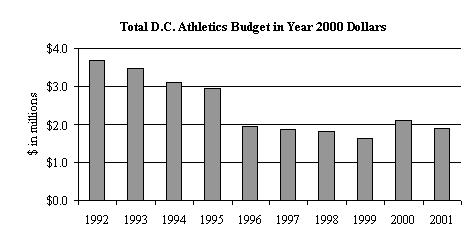
As a percentage of the overall DCPS budget, total activities and athletics funding has slipped from about 0.9% in 1993 to 0.6% this year. In contrast, Montgomery and Fairfax Counties spend a full 1.0% of their school budgets on athletics and student activities. Senior high athletics are 0.31% of the DCPS budget, compared to 0.62% and 0.76% of Montgomery and Fairfax budgets, respectively. As a result, D.C. high schools struggle to get basic equipment, supplies, uniforms, and transportation, readily available in these counties. Public funding alone is 65 to 90% more per senior high school student-athlete in the suburbs than in D.C. Even more disturbing is that while D.C. has not committed to sufficiently fund a basic athletic program, Fairfax County regularly provides funds for items completely absent in D.C.’s budget, from pool rentals and diving coaches to coaching education, which includes paid leave to attend seminars.
Budget per Pupil in D.C., Montgomery County and Fairfax County
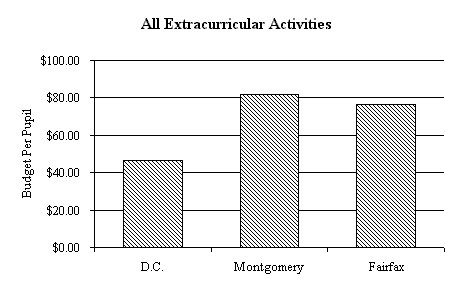
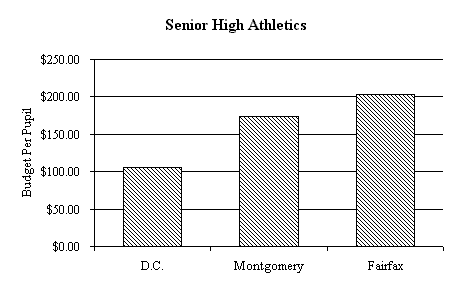
By our calculation it would take $900,000 to $1.25 million in additional funds to bring DCPS high school students to public funding comparability with Montgomery and Fairfax Counties on a per pupil basis. It would take $2 million to $2.4 million to achieve comparability for all activities for students at all levels.
D.C.’s insufficient public funding is exacerbated by the paucity of private funding that is a typical source of significant support for athletic programs at high schools throughout the rest of the region. Every one of Fairfax County’s and Montgomery County’s high schools has an active booster program. The money raised by suburban booster clubs can be significant. In Fairfax County, such clubs raise anywhere from $20,000 to $65,000 per year. Combined with gate receipts and concessions from athletic events, schools in Fairfax County average between $80,000 - $100,000 in extra revenue per school year, with several schools regularly raising well over that amount. Beyond the much-needed financial support, these booster clubs also increase parent involvement, heighten school spirit, and generate community and business support among those who might otherwise have limited involvement with the schools.3
Montgomery County high schools likewise benefit significantly from revenue derived from gate receipts, concession sales and booster clubs. These sources typically produce $40,000 in extra funding for each school, with up to $40,000 in additional support coming from the proceeds of school vending machine sales.4
In sharp contrast, gate receipts and concession sales at D.C. schools provide at best a few thousand dollars per school annually and very few schools have active booster clubs supporting particular teams. This ancillary support in either county adds up to roughly $2 million – the entire amount available to D.C. high school athletics. The suburban icing is the entire cake for D.C. student-athletes.
The results of the District’s starvation-level athletics funding are painfully obvious when one considers the opportunities for and participation of the students in three high schools that we visited: Cardozo Senior High in the District, Marshall Senior High in Fairfax County, and Springbrook Senior High in Montgomery County.5 Table 4 (Appendix) illustrates our findings. While boys at both Marshall and Springbrook High Schools are offered golf, lacrosse, swimming, diving, and wrestling, those at Cardozo are not. Nor does Cardozo have boys’ junior varsity teams in baseball or soccer. Cardozo’s offerings for female athletes are even more limited. Female athletic participation at Cardozo totaled only 41 for the entire 1999-2000 year, including 10 girls on the cheerleading squad. Apart from cheerleading, Cardozo girls have only one sport per season – volleyball in the fall, basketball in the winter and softball in the spring. Last year the softball team had only 9 players. In contrast, girls at Marshall and Springbrook also had the option of playing field hockey, gymnastics, lacrosse, soccer, swimming, diving, tennis, indoor and outdoor track, and cross country. Additionally, they had junior varsity teams in basketball, cheerleading, field hockey, soccer, softball and volleyball. Such a disparity clearly raises the question of D.C.’s compliance, or lack thereof, with Federal Title IX requirements for equitable athletic opportunities for boys and girls.
Each year, hundreds of boys and girls participate in athletic programs at both Marshall and Springbrook high schools, compared to 186 at Cardozo. Overall, taking enrollment into account, the rate of participation is two to three times higher at the suburban schools than at Cardozo.6 These ratios reflect system-wide disparities, as seen in Table 5 (Appendix). Poolesville High School in Montgomery County enrolls fewer students than Cardozo (719 versus 825), but has 33 teams to Cardozo’s 13. In fact the District’s most extensive school athletics program, at Wilson Senior High, has only 19 teams. Overall, DCPS reports a total of 3,456 high school athletics participants on 220 teams, including junior varsity, in 15 high schools.7
Fairfax County reports 22,190 athletic participants on over 1,000 teams in 24 high schools. The rate of participation is almost twice that in the District.
While the people—coaches, student-athletes, families and community—are the heart and soul of an athletic program, quality facilities and equipment are essential for a successful program. As the old adage goes, a picture is worth a thousand words. Instead of reiterating the sad truth that the D.C. Public School athletic facilities are, in the absolute sense, woefully deficient, we have chosen to visually illustrate their inadequacies by contrasting them with those provided to students in two neighboring jurisdictions.8 Accordingly, we visited a high school in the District (Cardozo), interviewed its Athletic Director, and photographed what we saw.9 We then visited, for comparative purposes, two typical high schools in the suburbs (Marshall in Fairfax County, VA and Springbrook in Montgomery County, MD), spoke with their Athletic Directors, and photographed what we saw. The different images are stark and deeply troubling.
| Cardozo High School | Marshall High School |
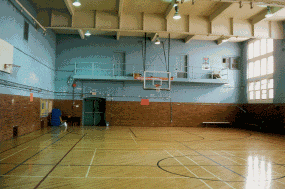 |
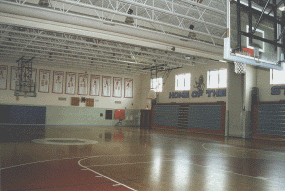 |
As you enter Cardozo’s two gyms you quickly realize that several basic things appear to be missing.10 There are no usable bleachers – they have been condemned for years. There are no water fountains; in fact, the nearest one to the boys’ gym is on another floor. There is no air-conditioning, no emergency exit and no scoreboard.
These are not new areas of concern. Thirteen years ago, a report commissioned by the Superintendent detailed similar problems with the Cardozo High School gyms. Among other things, the report concluded that:
"The basketball floors should be refinished for both boys and girls. The basketball goals need to be replaced also. Padding should be replaced behind the goals to prevent injuries. All these items are considered to be serious potential safety and health items…The bleachers in the gymnasium are damaged and should be repaired or replaced. Splintered bleachers can cause serious injuries."
Although some improvements have been made, the gyms are too small and remain unusable for interscholastic basketball competition. The result is that Cardozo students cannot enjoy the basic benefits that high schools throughout the suburbs enjoy – the benefits of having "home" basketball games filled with students, teachers, parents, and school spirit.11 The gym’s poor circulation, and lack of air-conditioning and water fountains, render it a danger zone for overheated and dehydrated student-athletes.
In contrast, Marshall High in Fairfax County contains a primary gym equipped with state of the art retractable bleachers, air-conditioning, water fountains and emergency exits. "Home" games are in fact played at home. Similarly, Springbrook High School’s gym is a modern well-maintained facility, meeting all of the basic needs of its student athletes. It looks and feels new, being extremely clean and well-lit. It is also interesting to note that both Springbrook’s and Marshall’s auxiliary gyms are in far better condition than either of the gyms at Cardozo.
| Cardozo High School | Marshall High School |
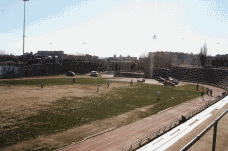 |
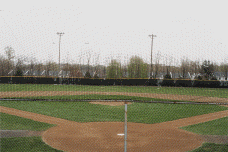 |
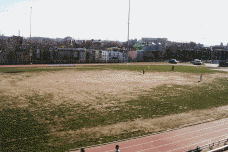 |
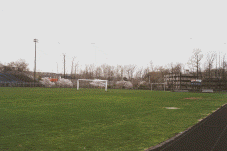 |
| Cardozo High School | Marshall High School |
Cardozo’s only athletic field has not been re-sodded since 1992. It has been abused by years of both inattention and over-use. Due to limited space on its campus, Cardozo’s field is used as a playing and practice field for football and soccer, and as a practice facility for baseball and softball.12 It is also used by local middle schools and junior high schools for football games. For urban high schools, land is at a premium. The entire site for Cardozo’s 355,000 square foot building is 8.97 acres. In contrast, Marshall High has separate fields for each sport; all are well-groomed, professionally landscaped and irrigated. Marshall’s baseball team enjoys home games, bleachers, team dugouts, a pitcher’s mound, a grass outfield complete with surrounding fence, and even lights that allow for nighttime play. Springbrook High School’s athletic fields are also in excellent condition. The school has devoted acres to its athletic complex, and provides well-groomed fields for each of its outdoor field sports. In Montgomery County, high schools are generally on sites of 40 acres or more. This responds in part to higher parking and bus turnaround requirements, but it is also to accommodate more playing fields and courts.
In the late 1980s, when the deficiencies of the D.C. Public School’s athletic programs were first chronicled, Cardozo High was among those cited. For example, the 1988 Report to the Superintendent noted that Cardozo’s "football field need[ed] to be re-sodded"; that there was the potential for "serious injuries." The Report further indicated that the "field events area i.e., the high jump pit, the long jump, etc., require[d] immediate attention"; that it too could "cause serious injury." Now, thirteen years later, the field still needs to be re-sodded, and the high jump and long jump pits are still overgrown with weeds. Additionally, a recent visit to Cardozo’s field found the track strewn dangerously with broken glass.
As for the spectators at Cardozo’s outside athletic events, they too are at risk. The football bleachers we inspected were crumbling. Indeed, they have been crumbling for years. As noted in the 1988 Report, "[t]he football bleachers are damaged and should be replaced to prevent injuries. These items were addressed many times in the past." Yet, they still have not been repaired.
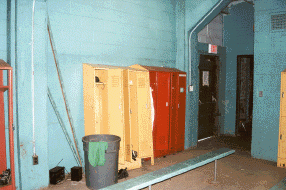 |
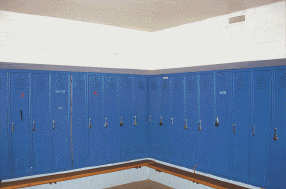 |
| Cardozo High School | Marshall High School |
Locker rooms can present a host of hazards if not properly maintained. In sharp contrast to schools in Montgomery and Fairfax Counties, Cardozo’s locker rooms present a range of serious problems.
Like its athletic fields and gymnasiums, in 1988 Cardozo’s locker rooms were the target of scathing criticism. Identifying them as a serious potential health hazard, the Superintendent’s Report indicated that "[t]he showers d[id] not operate properly. Showers in such a facility should be operative at all times." And though the showers did not work, water nonetheless managed to get in – unfortunately, through the ceiling. At the time, "[t]he locker room located at the football stadium ha[d] numerous leaks causing this area to deteriorate. Repairs ha[d] been required for several years."
Thirteen years later, the roof covering Cardozo’s locker room still leaks, sometimes completely flooding the floor. Last year not a single student-athlete or PE student took a shower in the school facilities – not necessarily because they did not want to, but because to do so risked a serious scalding. In fact, today, there is no cold drinking water in the locker rooms and one water fountain has actually been pulled off the wall. Many of the lockers are broken and have jagged edges, while the bathroom stalls have no doors. Clearly, conditions have become even worse.
The pictures tell a far different story for Marshall and Springbrook high schools. Locker rooms at both schools are spacious, functional and clean.
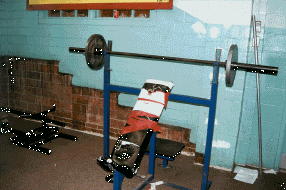 |
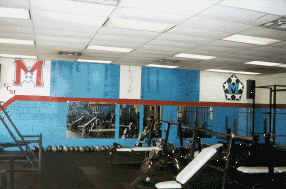 |
| Cardozo High School | Marshall High School |
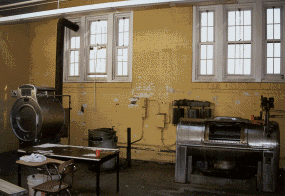 |
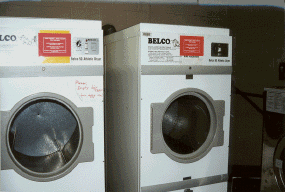 |
| Cardozo High School | Marshall High School |
Perhaps the most antiquated and dilapidated aspects of Cardozo’s athletic facilities are its laundry room and weight room. Its washer and dryer are original pieces of equipment installed decades ago. While aged laundry equipment does not necessarily pose a safety risk or impede student participation in athletics, it is yet another example of the city’s failure to modernize its facilities. The modern laundry facilities at Marshall High School are typical of facilities in suburban high schools.
The weight room sends an even stronger message. The first thing you notice upon entrance – besides the fact that the front door is broken – is how hot the room is. We visited Cardozo on a cool spring day, with temperatures in the low 60s. Nonetheless, the weight room was stifling; there was absolutely no ventilation and no air-conditioning. Remarkably, there was not even a water fountain.
As for the equipment, the pictures largely speak for themselves. Much of the equipment was old and in some cases unusable, with many bench mats held together by rolls of multi-colored tape, and, despite the 1988 recommendation, the floor was still not padded.
At Marshall, the equipment is much newer, the room is air-conditioned, the floor is padded, and water fountains are readily available. The weight room at Springbrook is equally well-equipped and attractive.
| Springbrook High School | Marshall High School | Marshall High School |
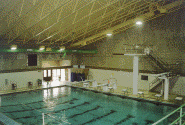 |
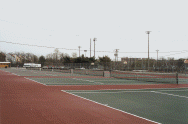 |
 |
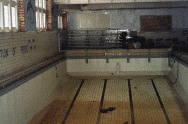 |
 |
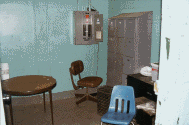 |
| Cardozo High School | Cardozo High School | Cardozo High School |
Again, the pictures speak for themselves. While Cardozo’s swimming pool has gone several years without water, and its tennis courts lack nets, Marshall and Springbrook both provide their student-athletes with excellent swimming and tennis facilities.16 Additionally, both Marshall’s and Springbrook’s athletic directors are afforded clean, decent offices in which to work. In contrast, Cardozo’s Athletic Director works out of a small, dingy space.
In assessing the consequences of an inadequate athletic program, it is helpful to note the benefits provided by a system that is well-equipped and well-funded. The benefits of a strong athletic program are extensive and widely regarded. Playing in sports can help keep young people motivated to stay in school and to continue on to higher education. Athletic participation can open college and career doors which might otherwise be inaccessible, especially to inner-city youth. Participation in athletics can lead students to acquire new skills such as organization, planning, and time management. Athletics also help students develop discipline and motivation. Numerous studies and anecdotal evidence support this fact:
A study conducted by the United States Department of Education’s National Center for Education Statistics concluded that compared to non-participants, student activities participants put more time into completing homework, had higher scores on standardized tests, and earned more course credits.
A survey of executives in 75 Fortune 500 companies indicated that 95 percent participated in sports during high school.
The September 1995 report "Adolescent Time Use, Risky Behavior, and Outcomes: An Analysis of National Data," by the Department of Health and Human Services, found that students who spend no time in extracurricular activities are 57 percent more likely to have dropped out of school by the time they would have been seniors; 49 percent more likely to have used drugs; 37 percent more likely to have become teen parents; 35 percent more likely to have smoked cigarettes; and 27 percent more likely to have been arrested than those who spend one to four hours per week in extracurricular activities.
Of the 60 students listed in the May 14, 1998, USA Today's All-USA High School Academic First, Second and Third Teams and the 51 who earned honorable mention, 75 percent were involved in sports, speech, music or debate.
The March 1996 Role of Sports in Youth Development meeting (Carnegie Corporation, New York), issued a report citing evidence that, at their best, sports programs promote responsible social behaviors and greater academic success, confidence in one’s physical abilities, an appreciation of personal health and fitness, and strong social bonds with individuals and institutions. Teachers attribute these results to the discipline and work ethic that sports require.
Former Supreme Court Justice and noted college and professional football player, Byron White, wrote: "Sports . . . provide educational experience which cannot be duplicated in the classroom. In any athletic activity we are thrown upon our resources to succeed in the face of a strong and immediate challenge. Sports resemble life in capsule form. Participants quickly learn that their performance depends upon the development of strength, stamina, self-discipline and a sure and steady judgment."
Unfortunately, DCPS students are significantly deprived of the benefits of participating in a quality athletic program. The District’s athletic programs are severely inhibited by insufficient funding and the physical limitations of the facilities in which they operate. The District’s continued neglect of these programs has very real costs for DCPS’s students. A compromised athletic program stunts not only the student’s physical growth, but his/her academic and social growth as well.
The opportunity to compete can contribute significantly to personal growth, as competition is not simply about winning or losing a basketball or football game, but about succeeding in the challenge of life. However, the District’s high school sports teams operate at a severe competitive disadvantage. Regrettably, as a result they are regularly defeated by far better funded and far better equipped teams from private schools and public schools from the suburbs.13 While it may be said that losing builds character, regularly competing and being badly defeated by schools with more coaches, better facilities and superior equipment is not likely to engender long term benefits or encourage increased student participation. Simply put, a second- or third-rate athletic program is constantly demoralizing.
Though unproven, it seems obvious that strong athletic and extracurricular programs could help to reduce the system’s extremely high drop-out rate. The drop-out rate for D.C. senior high students exceeds one third, with a disproportional number of drop-outs being boys. A student’s difficulty with academic studies is often a motivating factor to leave school. However, for many students, it is clear that a strong athletics and student activities program can combat disillusionment and provide an opportunity to excel and feel a valued part of the student body.
The District’s poor athletic programs also hurt a student-athlete’s opportunity for college scholarships. The poor reputation of the District’s athletic programs is a reason college scouts may overlook D.C. schools and deserving students are thus denied opportunities to attend colleges with financial aid. This is particularly true for students at schools with less experienced and less senior coaches, who lack historical contacts with college recruiters.
The state of the D.C. system makes it susceptible to legal liability and enormous monetary exposure. In recent years, a number of school systems throughout the country have been found liable for large judgments in cases far less serious than those that could easily arise in the District. Lack of proper equipment, unsafe facilities, and inadequately supported coaches are all causes of action.14 Investing now in programs and facilities could well save the District millions in potential future lawsuits and judgments.
Moreover, in seeking the previously denied athletics funding increase, the school system cited its apprehension of "falling out of compliance with Title IX," a situation that could result in private lawsuits or the withholding of federal funds.15
The deplorable state of the D.C. Public Schools’ athletic programs and facilities should surprise no one. But the message communicated by these sad conditions is in fact shocking. The message is that the D.C. community does not sufficiently value its children to ensure a safe environment where students can explore a range of athletic opportunities.
The solution rests with the entire D.C. community. First, and foremost, the city government needs to allocate far more money to the D.C. Public Schools’ athletic programs. A minimum addition of $900,000 to $1,250,000 annually is needed for the District’s athletic programs operating budget to reach a level comparable to those of suburban jurisdictions. This needs to be a net infusion of additional funds to DCPS, not a shift ("robbing Peter to pay Paul") from one under-funded school program to another. The D.C. Public Schools must commit to and carry out an aggressive review and upgrading of its athletic programs with the objective of comprehensively addressing the various shortcomings cited in this and prior reports.
Second, working with the local schools, the Department of Parks and Recreation, the Sports Commission, sports professionals, and advocates for the 2012 Olympics, a supplement to the Master Plan needs to be developed that assesses the immediate and long term requirements of all D.C. high school athletic facilities, i.e. stadiums, fields, gyms, and locker rooms. The review should establish criteria for prioritizing projects and determine the level of maintenance, repair and capital support that are needed to bring the District’s athletic facilities to an acceptable level and maintain them at this standard.
Third, we recommend the creation of a private foundation charged with the task of raising private funds to supplement the funding of D.C. Public Schools at a level at least equal to the funding routinely provided by private sources to high schools in Fairfax and Montgomery counties. We believe a target figure of $100,000 per high school per year is the approximate goal for this effort. The task of establishing and operating this foundation should be conducted by an appropriate group of business and civic leaders, hopefully including parents of student athletes and representatives of professional and collegiate sports teams, related sports professionals, and leagues operating in the D.C. area. Support efforts, if successful, can help to build attendance, attract sponsorship and advertisers, and increase the visibility and quality of athletics overall.
In conclusion, while this study points out significant problems and needs, it reiterates, for the most part, long standing shortcomings disclosed many times before. The need for significant additional funds and aggressive, committed leadership is clear. The question is not so much what should be done. The question is: will it?
|
$ in thousands |
||||||||||
|
1992 |
1993 |
1994 |
1995 |
1996 |
1997 |
1998 |
1999 |
2000 |
2001 |
|
|
Approved Budget for Athletics Department |
||||||||||
|
PS |
NA |
NA |
$ 939 |
$ 1,112 |
NA |
$ 927 |
$ 704 |
$ 620 |
$ 974 |
$ 1,073 |
|
OTPS |
NA |
NA |
$ 1,729 |
$ 1,498 |
NA |
$ 800 |
$ 1,000 |
$ 950 |
$ 1,105 |
$ 868 |
|
Total Athletics Department Budget |
$ 2,999 |
$ 2,918 |
$ 2,668 |
$ 2,610 |
$ 1,766 |
$ 1,727 |
$ 1,704 |
$ 1,570 |
$ 2,079 |
$ 1,941 |
|
Coaches & Sponsors Stipends |
NA |
$ 1,688 |
$ 1,688 |
$ 1,688 |
$ 1,688 |
$ 1,679 |
NA |
$ 1,600 |
$ 1,670 |
$ 1,920 |
|
Total Athletics Activities Budget |
NA |
$ 4,606 |
$ 4,356 |
$ 4,298 |
$ 3,454 |
$ 3,406 |
NA |
$ 3,170 |
$ 3,749 |
$ 3,861 |
|
Positions covered by Athletics Dept budget |
||||||||||
|
Central staff |
NA |
NA |
9 |
9 |
7 |
7 |
7 |
5 |
5 |
5 |
|
Trainers |
NA |
NA |
13 |
13 |
11 |
11 |
11 |
11 |
11 |
11 |
|
Total DCPS Budget (local funds) |
$519,300 |
$513,500 |
$517,600 |
$542,681 |
$503,270 |
$482,514 |
$460,143 |
$545,000 |
$599,636 |
$641,388 |
|
Athletics Dept as % of Total Local Budget |
0.58% |
0.57% |
0.52% |
0.48% |
0.35% |
0.36% |
0.37% |
0.29% |
0.35% |
0.30% |
|
Athletics Activities as % of Total Local Budget |
NA |
0.90% |
0.84% |
0.79% |
0.69% |
0.71% |
NA |
0.58% |
0.63% |
0.60% |
|
Total Athletics Dept. Budget in Yr '00 Dollars |
$ 3,681 |
$ 3,477 |
$ 3,100 |
$ 2,949 |
$ 1,938 |
$ 1,853 |
$ 1,800 |
$ 1,623 |
$ 2,079 |
$ 1,883 |
|
Stipends Budget in Yr '00 Dollars |
NA |
$ 2,012 |
$ 1,961 |
$ 1,907 |
$ 1,853 |
$ 1,801 |
NA |
$ 1,654 |
$ 1,670 |
$ 1,863 |
|
Total Athletics Activites Budget in Yr '00 Dollars |
NA |
$ 5,489 |
$ 5,061 |
$ 4,856 |
$ 3,791 |
$ 3,654 |
NA |
$ 3,277 |
$ 3,749 |
$ 3,746 |
Sources: Budget Data: Documents issues by DCPS Budget Division. Positions: Derived from DCPS payroll data.
|
1999-00 |
2000-01 |
2000-01 |
||||
|
Cardozo SHS |
Marshall SHS |
Springbrook SHS |
||||
|
District of Columbia |
Farifax County |
Montgomery County |
||||
|
Sport |
Offered? |
# Athletes |
Offered? |
# Athletes |
Offered? |
# Athletes |
|
Baseball (B) |
X |
17 |
X |
19 |
X |
15 |
|
Baseball (B) JV/MS |
- |
- |
X |
17 |
X |
14 |
|
Basketball (B) |
X |
13 |
X |
13 |
X |
14 |
|
Basketball (B) JV/MS |
X |
12 |
X |
28 |
X |
14 |
|
Basketball (G) |
X |
10 |
X |
11 |
X |
15 |
|
Basketball (G) JV/MS |
- |
- |
X |
21 |
X |
15 |
|
Cheerleading (G) |
X |
10 |
X |
43 |
X |
15 |
|
Cheerleading (G) JV/MS |
- |
- |
X |
33 |
X |
20 |
|
Crew |
- |
- |
- |
- |
- |
- |
|
Field Hockey (G) |
- |
- |
X |
17 |
X |
19 |
|
Field Hockey (G) JV/MS |
- |
- |
X |
16 |
X |
15 |
|
Football (B) |
X |
43 |
X |
58 |
X |
33 |
|
Football (B) JV/MS |
X |
22 |
X |
32 |
X |
46 |
|
Golf (B/G) |
- |
- |
X |
11 |
X |
8 |
|
Gymnastics (B) |
- |
- |
X |
3 |
- |
- |
|
Gymnastics (G) |
- |
- |
X |
17 |
X |
14 |
|
Lacrosse (B) |
- |
- |
X |
24 |
X |
44 |
|
Lacrosse (B) JV/MS |
- |
- |
X |
31 |
- |
- |
|
Lacrosse (G) |
- |
- |
X |
20 |
X |
26 |
|
Lacrosse (G) JV/MS |
- |
- |
X |
27 |
- |
- |
|
Poms (G) |
- |
- |
- |
- |
X |
11 |
|
Soccer (B) |
X |
14 |
X |
19 |
X |
18 |
|
Soccer (B) JV/MS |
- |
- |
X |
18 |
X |
19 |
|
Soccer (G) |
- |
- |
X |
18 |
X |
18 |
|
Soccer (G) JV/MS |
- |
- |
X |
18 |
X |
16 |
|
Softball (G) |
X |
9 |
X |
13 |
X |
12 |
|
Softball (G) JV/MS |
- |
- |
X |
17 |
X |
16 |
|
Swim & Dive (B/G) |
- |
- |
X |
44 |
X |
47 |
|
Tennis (B) |
X |
7 |
X |
15 |
X |
17 |
|
Tennis (G) |
- |
- |
X |
16 |
X |
9 |
|
Track X Country (B/G) |
- |
- |
X |
33 |
X |
44 |
|
Track Indoor (B/G) |
X |
6 |
X |
40 |
X |
63 |
|
Track Outdoor (B/G) |
X |
7 |
X |
45 |
X |
51 |
|
Volleyball (Coed) |
- |
- |
- |
- |
X |
14 |
|
Volleyball (B) |
- |
- |
- |
- |
X |
17 |
|
Volleyball (G) |
X |
12 |
X |
12 |
X |
12 |
|
Volleyball (G) JV/MS |
- |
- |
X |
12 |
X |
13 |
|
Wrestling (B) |
- |
- |
X |
41 |
X |
17 |
|
Wrestling (B) JV/MS |
- |
- |
- |
- |
X |
17 |
|
Total Number of Teams |
13 |
34 |
35 |
|||
|
Total Number of Athletes* |
182 |
802 |
758 |
|||
|
Total Enrollment |
825 |
1202 |
1961 |
|||
|
Ratio, Athletes to Enrollment |
0.22 |
0.67 |
0.39 |
|||
*Total No. athletes counts all athletes listed on each team's roster; students who play more than one sport are counted multiple times.
|
1999-00 |
2000-01 |
2000-01 |
||||
|
Cardozo SHS |
Poolesville SHS |
Wilson SHS |
||||
|
District of Columbia |
Montgomery County |
District of Columbia |
||||
|
Sport |
Offered? |
# Athletes |
Offered? |
# Athletes |
Offered? |
# Athletes |
|
Baseball (B) |
X |
17 |
X |
13 |
X |
22 |
|
Baseball (B) JV/MS |
- |
- |
X |
14 |
- |
- |
|
Basketball (B) |
X |
13 |
X |
12 |
X |
22 |
|
Basketball (B) JV/MS |
X |
12 |
X |
NA |
X |
14 |
|
Basketball (G) |
X |
10 |
X |
NA |
X |
16 |
|
Basketball (G) JV/MS |
- |
- |
X |
NA |
- |
- |
|
Cheerleading (G) |
X |
10 |
X |
NA |
X |
19 |
|
Cheerleading (G) JV/MS |
- |
- |
X |
NA |
- |
- |
|
Crew |
- |
- |
- |
- |
X |
72 |
|
Field Hockey (G) |
- |
- |
X |
NA |
- |
- |
|
Field Hockey (G) JV/MS |
- |
- |
X |
NA |
- |
- |
|
Football (B) |
X |
43 |
X |
NA |
X |
43 |
|
Football (B) JV/MS |
X |
22 |
X |
NA |
X |
44 |
|
Golf (B/G) |
- |
- |
X |
NA |
- |
- |
|
Gymnastics (B) |
- |
- |
- |
- |
- |
- |
|
Gymnastics (G) |
- |
- |
- |
- |
- |
- |
|
Lacrosse (B) |
- |
- |
X |
29 |
- |
- |
|
Lacrosse (B) JV/MS |
- |
- |
- |
- |
- |
- |
|
Lacrosse (G) |
- |
- |
X |
26 |
- |
- |
|
Lacrosse (G) JV/MS |
- |
- |
- |
- |
- |
- |
|
Poms (G) |
- |
- |
- |
- |
- |
- |
|
Soccer (B) |
X |
14 |
X |
NA |
X |
33 |
|
Soccer (B) JV/MS |
- |
- |
X |
NA |
- |
- |
|
Soccer (G) |
- |
- |
X |
NA |
X |
43 |
|
Soccer (G) JV/MS |
- |
- |
X |
NA |
- |
- |
|
Softball (G) |
X |
9 |
X |
13 |
X |
10 |
|
Softball (G) JV/MS |
- |
- |
X |
17 |
- |
- |
|
Swim & Dive (B/G) |
- |
- |
X |
NA |
X |
42 |
|
Tennis (B) |
X |
7 |
X |
10 |
X |
10 |
|
Tennis (G) |
- |
- |
X |
NA |
X |
8 |
|
Track X Country (B/G) |
- |
- |
X |
NA |
X |
21 |
|
Track Indoor (B/G) |
X |
6 |
X |
NA |
X |
34 |
|
Track Outdoor (B/G) |
X |
7 |
X |
56 |
X |
44 |
|
Volleyball (Coed) |
- |
- |
X |
13 |
- |
- |
|
Volleyball (B) |
- |
- |
X |
10 |
- |
- |
|
Volleyball (G) |
X |
12 |
X |
NA |
X |
23 |
|
Volleyball (G) JV/MS |
- |
- |
X |
NA |
- |
- |
|
Wrestling (B) |
- |
- |
X |
NA |
X |
24 |
|
Wrestling (B) JV/MS |
- |
- |
X |
NA |
- |
- |
|
Total Number of Teams |
13 |
33 |
19 |
|||
|
Total Number of Athletes* |
182 |
213** |
544 |
|||
|
Total Enrollment |
825 |
719 |
1510 |
|||
|
Ratio, Athletes to Enrollment |
0.22 |
0.30 |
0.36 |
|||
*Total no. athletes counts all athletes listed on each
team's roster; students who play more than one sport are counted multiple
times.
** Imcomplete total number of athletes for Poolesville.
|
2000-2001 |
Ave. D.C. |
||||
|
Category |
D.C. |
Montgomery |
Fairfax |
Arlington |
Pay Difference |
|
Athletic Director |
$ 2,433 |
$ 3,850 |
$ 3,604 |
$ - |
$ 1,294 |
|
Football |
$ 2,280 |
$ 4,845 |
$ 3,604 |
$ 5,293 |
$ 2,301 |
|
Football Assistant |
$ 1,105 |
$ 4,144 |
$ 2,458 |
$ 3,737 |
$ 2,341 |
|
Basketball |
$ 1,898 |
$ 4,233 |
$ 3,604 |
$ 4,048 |
$ 2,064 |
|
Basketball Assistant |
$ 1,105 |
$ - |
$ 2,458 |
$ 3,269 |
$ 1,759 |
|
Baseball |
$ 1,898 |
$ 4,450 |
$ 3,396 |
$ 4,048 |
$ 2,067 |
|
Baseball Assistant |
$ 1,105 |
$ - |
$ 2,458 |
$ 3,269 |
$ 1,759 |
|
Softball |
$ 1,898 |
$ 4,450 |
$ 3,396 |
$ 4,048 |
$ 2,067 |
|
Outdoor Track |
$ 1,898 |
$ 3,519 |
$ 3,396 |
$ 4,048 |
$ 1,756 |
|
Volleyball |
$ 1,898 |
$ 3,124 |
$ 3,396 |
$ 3,269 |
$ 1,365 |
|
Soccer |
$ 1,590 |
$ 3,213 |
$ 3,396 |
$ 3,737 |
$ 1,859 |
|
Swimming |
$ 1,590 |
$ 2,741 |
$ 3,396 |
$ 2,491 |
$ 1,286 |
|
Tennis |
$ 1,590 |
$ 2,882 |
$ 1,752 |
$ 2,491 |
$ 785 |
|
Cheerleaders |
$ 1,140 |
$ 6,719 |
$ 3,396 |
$ 3,269 |
$ 3,321 |
|
Wrestling |
$ 1,057 |
$ 4,514 |
$ 3,396 |
$ 4,048 |
$ 2,929 |
|
Cross Country |
$ 1,057 |
$ 3,353 |
$ 2,458 |
$ 2,803 |
$ 1,815 |
|
Field Hockey |
$ 1,057 |
$ 3,213 |
$ 3,396 |
$ 3,737 |
$ 2,392 |
|
Gymnastics |
$ 1,057 |
$ 1,670 |
$ 3,396 |
$ 3,269 |
$ 1,722 |
|
Indoor Track |
$ 1,057 |
$ 3,086 |
$ 2,458 |
$ 2,803 |
$ 1,726 |
|
Lacrosse |
$ 1,057 |
$ 3,175 |
$ 3,396 |
$ 3,737 |
$ 2,379 |
|
00-01 |
96-97 |
99-00 |
95-96 |
96-97 |
97-98 |
99-00 |
Ave. D.C. |
|
|
Category |
D.C. |
Minneapolis |
Cincinatti |
Wichita |
Boston |
Rochester |
Pittsburgh |
Pay Difference |
|
Athletic Director |
$ 2,433 |
$ 5,500 |
$ 5,256 |
$ 5,185 |
- |
- |
- |
$ 2,881 |
|
Football |
$ 2,280 |
$ 4,650 |
$ 4,668 |
$ 4,130 |
$ 7,126 |
$ 4,000 |
$ 5,552 |
$ 2,741 |
|
Basketball |
$ 1,898 |
$ 4,650 |
$ 3,797 |
$ 4,130 |
$ 4,681 |
$ 4,000 |
$ 5,552 |
$ 2,570 |
|
Baseball |
$ 1,898 |
$ 3,750 |
$ 2,139 |
$ 2,418 |
$ 4,414 |
$ 3,500 |
$ 3,452 |
$ 1,381 |
|
Softball |
$ 1,898 |
$ 3,750 |
$ 2,139 |
$ 2,418 |
$ 4,414 |
$ 3,500 |
$ 3,452 |
$ 1,381 |
|
Outdoor Track |
$ 1,898 |
$ 3,750 |
$ 2,139 |
$ 3,191 |
$ 3,162 |
$ 3,500 |
$ 3,053 |
$ 1,235 |
|
Volleyball |
$ 1,898 |
$ 4,650 |
$ 2,139 |
$ 2,275 |
$ 2,730 |
$ 3,000 |
$ 2,961 |
$ 1,061 |
|
Soccer |
$ 1,590 |
$ 3,750 |
$ 2,139 |
$ 2,418 |
$ 3,385 |
$ 3,000 |
$ 2,476 |
$ 1,271 |
|
Swimming |
$ 1,590 |
$ 4,650 |
$ 2,139 |
$ 2,532 |
$ 3,800 |
$ 3,000 |
$ 2,961 |
$ 1,590 |
|
Tennis |
$ 1,590 |
$ 2,850 |
$ 1,426 |
$ 1,724 |
$ 1,901 |
$ 2,500 |
$ 1,642 |
$ 417 |
|
Cheerleaders |
$ 1,140 |
$ 1,950 |
$ 1,284 |
- |
$ 1,901 |
- |
- |
$ 572 |
*Stipends for head coach of varsity teams.
1. The trouble areas identified in the Washington Post articles included unsafe facilities such as fields, bleachers, locker rooms, and weight rooms; insufficient or inadequate equipment; poorly paid and trained coaches; and the lack of ambulances at athletic events. Each of these four identified problems has led to lawsuits in other jurisdictions, several of which resulted in multi-million dollar judgments against the school district.
2. DCPS asked for a budget increase of $1 million to improve girls’ athletics next year, as part of a much larger package of increases. The Mayor and Council denied all these increases, since a teacher pay increase and rapidly rising special education costs will inevitably exceed re-allocated funds this proposal almost certainly cannot be funded.
3. Interviews with Bruce Patrick, Director of Student Activities for the Fairfax County Schools, and the athletic department staff at several Fairfax High Schools, including those at Marshall, Chantilly, Centreville, and Oakton.
4. D.C. athletic programs do not receive funding from school vending machines.
5. These schools were chosen on the basis of access, facilities and characteristics. In D.C., the Washington Lawyers’ Committee coordinated a long-standing partnership between Cardozo and a law firm. In Fairfax County, Marshall High School has been used for comparative purposes in the past, and has a highly diverse population. Springbrook High School in Montgomery County also has a particularly diverse student body and its principal, Michael Durso, previously served as the principal at Wilson High School in the District.
6. DCPS funding is offered for more sports than Cardozo has – but given the facilities deficiencies described in this report (such as a field with almost no grass and a pool without water) and the struggle for inadequately funded basic equipment, it is hardly surprising that many students choose not to participate. Moreover, the meager stipends for the hard work and serious responsibilities of coaching require more altruism than many teachers can afford.
7. The figures in this paragraph represent the sum of participants in all teams – individual students who play more than one sport are counted more than once.
8. Facilities in all three are reasonably representative of their school districts. In D.C., Cardozo was chosen because it is an older facility and suffers from many problems typical of those throughout the system. In Fairfax County, Marshall High School was chosen as it too is an older facility with about 1,200 students, and is close to the scale of D.C. high schools. Springbrook High School in Montgomery County was chosen because of its diversity and access.
9. Cardozo, built in 1916, is the District’s oldest comprehensive high school, but overall is rated as in better condition and less costly to renovate than most of the others. The 1998 Army Corps of Engineers facility assessment rated all but one of the comprehensive high schools as being in overall poor condition, with Cardozo fourth-best among the ten of them. DCPS Educational Facilities Master Plan, January 2000, p. 4-13. Cardozo is recommended for full modernization of that part of the facility appropriate to the current level of enrollment (with the remainder used for other compatible purposes). Four other are recommended for full modernization; two for new buildings; three for partial modernization. The estimated cost for the modernization is less than that of seven of the ten. Facility Master Plan, December 1, 2000, Building Profiles.
10. Cardozo has two gyms, one generally used by girls and the other by boys. They are identical in size.
11. For a number of years Cardozo has played its "home" basketball games at another high school facility.
12. Cardozo uses the facilities of another high school, Banneker, for its baseball games.
13. Out of almost 600 athletes honored as members of the Washington Post’s All-Metropolitan 2000-2001 Teams, only 16 were from the DCPS system.
14. Leahy v. Sch. Bd. of Hernando Ct., 450 So.2d 883 (Fla. Dist. Ct. of App. 1984); Baker v. Briarcliff Sch.Dist. 613 N.Y.S.2d 660 (N.Y. App. Div. 1994)
15. Proposed Operating Budget for FY 2002, p. 56.
16. All high schools in Fairfax and Montgomery counties have active swim teams that use modern county recreation center pools and diving facilities. Only 5 of the District’s high schools have pools, with 2 more close in location to public pools; only 4 schools have swim teams.
![]()
Send mail with questions or comments to webmaster@dcwatch.com
Web site copyright ©DCWatch (ISSN 1546-4296)